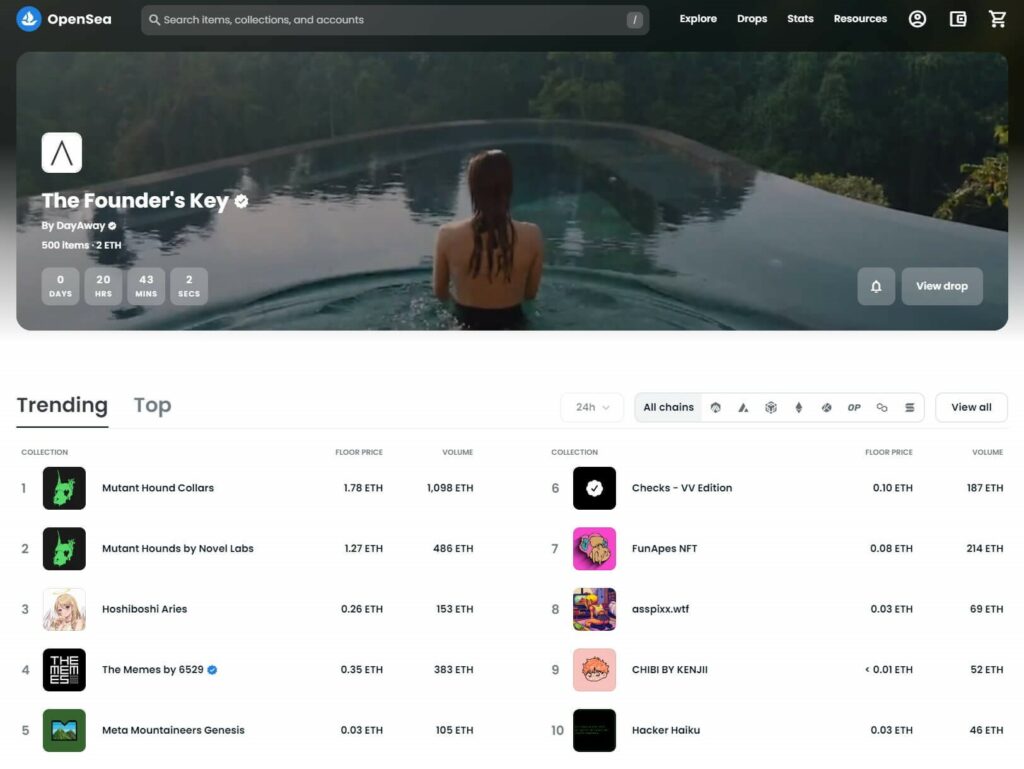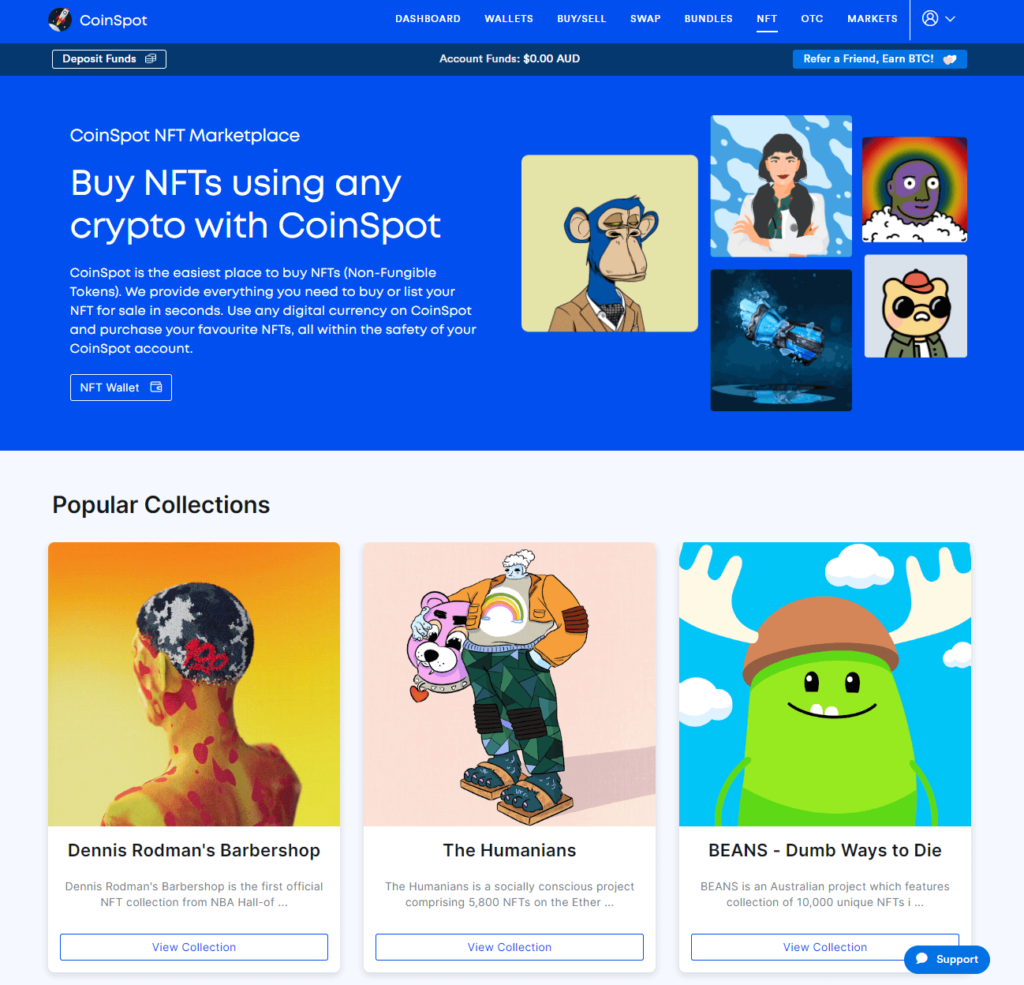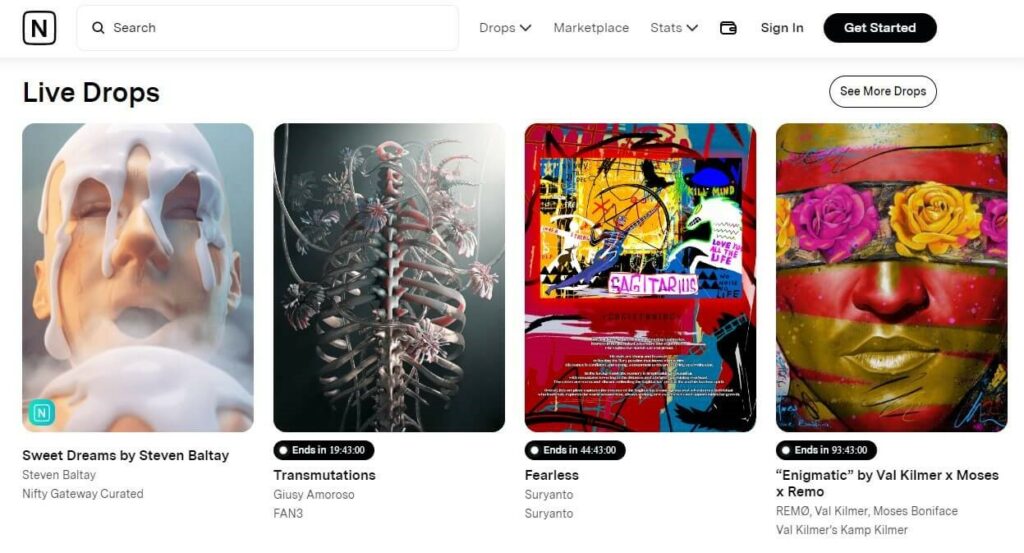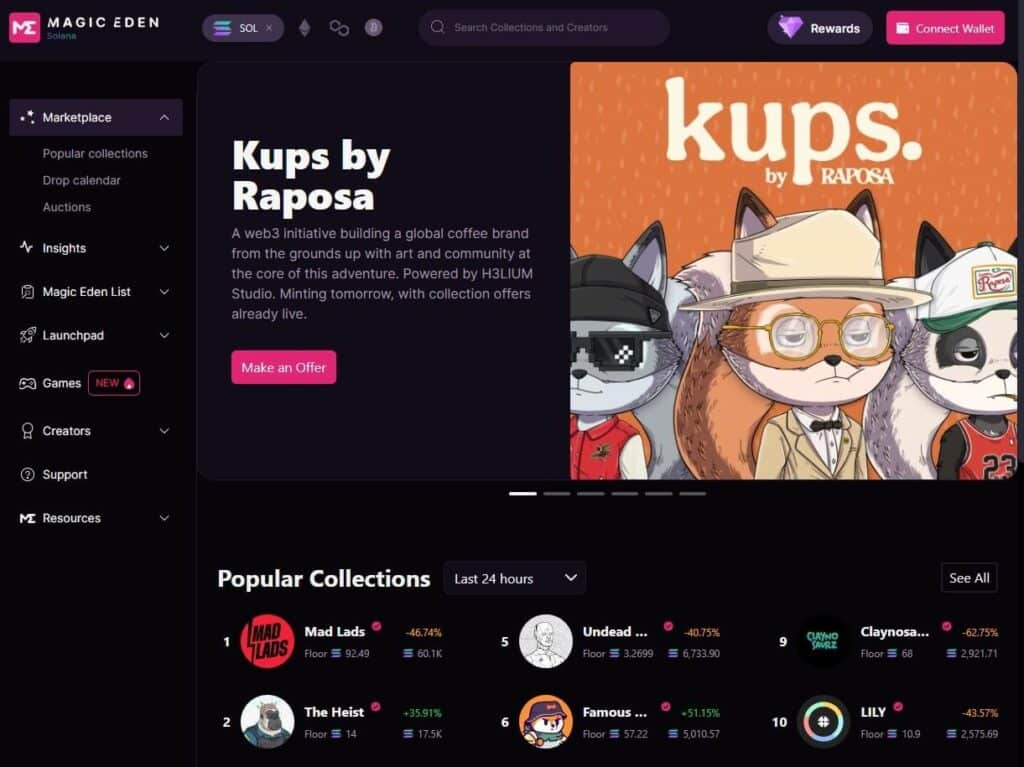Best NFT Marketplaces In Australia
Last Updated on January 31, 2024 by Kevin GrovesNon-Fungible Tokens (NFTs) have taken the cryptocurrency world by storm in recent years. The places where you can buy your digital art pieces and collectibles have also increased, making it hard to know which are the best ones to go to.
In this review, we identify and rank the top marketplaces to buy and trade NFTs in Australia. We pick out the features of each trading platform, the benefits and limitations that they bring, and how they compare to each other.
Best NFT Marketplaces For Australians To Use
We have assessed over 20 NFT marketplaces that are available to Australian investors and crypto enthusiasts. These are some of the best places to buy and trade NFTs in Australia due to their features, value for money, expansive collections, and ease of use.
- OpenSea – Best overall NFT marketplace in Australia
- CoinSpot – Best NFT marketplace for everyday Aussies
- Binance Australia – Best NFT marketplace for gamers
- Rarible – Best for NFT creators
- Nifty Gateway – Good variety of payment options
- Magic Eden – Best for trading fee discounts
Affiliate Disclaimer: We are reader supported and may earn a commission when clicking through the product links. This helps us grow the content and support the website.
Top Australian NFT Marketplaces: Our Reviews
Here are our reviews of the best marketplaces to buy and sell NFTs in Australia.
1. OpenSea – Best overall NFT marketplace in Australia
Founded in 2017, OpenSea is one of the largest NFT marketplaces in the world with a staggering offering of over 2 million collections, 80 million individual NFTs and over $20 billion of trades completed. You can browse through their multiple NFT categories which include art, collectibles, domain names, music, photography, sports, trading cards, virtual worlds, and more.
One of the distinguishing features of OpenSea is that it supports several blockchain networks rather than just the Ethereum network. For example, NFTs can be hosted on the Arbitrum, Avalanche, BNB Chain, Ethereum, Klaytn, Optimism, Polygon, and Solana networks. This allows OpenSea to support a much higher range of NFTs for its customers as well as provide flexibility in how NFTs are transferred.
The other distinguishing feature of OpenSea is its compatibility with numerous storage wallets where you can store your NFTs. Integrating your own wallet is a great way of giving yourself full custody (and responsibility) of your NFTs. Wallets that OpenSea supports include the ever-popular MetaMask, TrustWallet, Torus, Coinbase Wallet, Glow, and Portis.

However, the strength of OpenSea as a reliable marketplace is not limited to its vast collection of NFTs. Some of the features that elevate OpenSea above the rest include:
- A simple and visually stunning interface that makes the NFT browsing, buying, and selling process easy and enjoyable.
- Multiple payment methods to buy NFTs including cryptocurrency (ETH/WETH), SOL, AVAX, USDC, BNB, and DAI. Credit and debit cards can be used to directly purchase NFTs via OpenSea’s third-party payment provider, MoonPay.
- Advanced search filters to help you find the digital asset you want to buy.
- Access to Primary Drops where you can be first in line to purchase newly minted NFTs.
- A “Sweep” feature where you purchase multiple NFTs in a single transaction.
In terms of fees, OpenSea has some pros and cons. For sellers, you will incur a fee of 2.5% of the sale price plus the gas fee to facilitate the transaction. Creating or minting new NFTs can be done free of charge and there is no gas fee that applies. Buyers only need to pay for the gas fee as OpenSea doesn’t charge any buying fees.
Overall, OpenSea provides all the qualities of a premium NFT marketplace that is suited for the wider community. There is no shortage of NFT collections to view, you have multiple ways to pay for an NFT, and you connect your wallet for easy and secure storage. However, one of the downsides is the requirement to connect your own wallet.
OpenSea Pros
- One of the largest NFT collections in the world.
- An easy-to-use interface that makes it easy to buy, sell, and manage NFTs.
- Zero fees to buy NFTs (with the exception of a gas fee).
- Buy NFTs using crypto (ETH, WETH, SOL, AVAX, USDC, BNB, and DAI) or with a credit/debit card.
- Supports several blockchain networks rather than just Ethereum.
OpenSea Cons
- Some may not be familiar with connecting a wallet to store their NFTs.
2. CoinSpot – Best NFT marketplace for everyday Aussies
Based in Melbourne, CoinSpot is one of the best Australian crypto exchanges. On top of its provision of reliable cryptocurrency trading services, CoinSpot has entered into the NFT industry with its own marketplace.
CoinSpot currently lists 32 collections with over 404,000 individual digital works and art pieces including those from the popular Bored Ape Yacht Club, Cool Cats, and Invisible Friends. Whilst the number of collections is not as exhaustive as OpenSea, it is one of the biggest NFT marketplaces hosted by a locally owned and operated Australian company. If you prefer to buy locally, then CoinSpot is your best option.
Buying NFTs on CoinSpot will incur a flat service fee of 0.9% which doesn’t include the gas fee that goes on top. Comparatively, its 0.9% fee is quite competitive compared to other NFT marketplaces.

The other reason why you might prefer CoinSpot is its ease of use. Since the overarching platform is designed for beginners, CoinSpot’s NFT marketplace follows the same design philosophy where browsing the various collections and making purchases are about as simple as it gets.
To further substantiate its claim as a highly secure and trustworthy NFT storage solution, NFTs that you buy are near-instantly transferred to your NFT Wallet which is protected by state-of-the-art security protocols. In addition to its best practice storage protocols, CoinSpot has attained ISO 27001 accreditation which means that the platform adheres to higher standards regarding its information and security management processes. This includes the storage of NFTs.
CoinSpot has been a leader in the Australian crypto market since its inception in 2013. You can find out more about its features in our CoinSpot review.
CoinSpot Pros
- 100% Australian-owned and operated company.
- The interface of the NFT marketplace is easy to use and navigate.
- A substantial range of NFT collections to browse.
- A service fee of 0.9%.
- Buy NFTs with any of CoinSpot’s 370+ supported cryptocurrencies.
CoinSpot Cons
- Not the largest range of collections compared to global NFT marketplaces.
3. Binance Australia – Best NFT marketplace for gamers
Binance Australia has significantly bolstered its digital art collection and is now one of the best NFT marketplaces in Australia. The lost-cost trading platform now offers a user focussed NFT experience which is aimed at the general public. With over 1,000 collections, Binance hosts a diverse range of artworks and collectibles including sports, gaming, esports, and entertainment. Services are not limited to solely buying NFTs as you can also sell and mint them.
The NFT market is best known for its top-tier gaming, Initial Game Offerings (IGOs). The world’s first and largest IGO project, a broad range of premium projects are hosted to help crypto enthusiasts get started on their Metaverse journey. A highly attractive option for gamer enthusiasts.

All NFT transactions on Binance occur on the Ethereum and Binance Smart Chain (BSC) networks which means that traders can transfer NFTs without a third party acting as a middle-man. This also means that you can send your purchased NFT to a wide range of wallets such as MetaMask, Trust Wallet, Zengo, and Coinbase Wallet.
Apart from gaining access to Binance’s diverse range of NFTs on an easy-to-use platform, the platform offers moderately competitive fees to sell digital assets and collectibles. Listing and selling an NFT will set you back 1% of the transaction amount plus a royalty fee between 0% and 10% that is paid to the original artist. Similar to other NFT platforms, there are zero fees to buy NFTs. However, a variable gas fee will apply to facilitate the transaction. Gas fees on the Ethereum network can add up over time so being able to trade NFTs on the BSC network where gas fees may be cheaper is an advantage.
Binance Australia Pros
- An easy-to-use and secure platform that suits NFT novices.
- Supports the Ethereum and BSC networks.
- No fees to buy NFTs (except mandatory gas fees).
Binance Australia Cons
- The rest of Binance’s services and features may be confusing for some.
4. Rarible – Best for NFT creators
Rarible is another very popular marketplace for NFTs. At the time of writing, Rarible has over $374M of trading volume, 405k NFTs created and 1.6 million users which is impressive since the platform launched in 2020. The NFT platform has proven itself to be a safe place to trade digital art, collectibles, music and video NFTs, domain names, metaverse lands and wearables in a marketplace environment.

Historically, Rarible allowed you to buy digital collectibles with ETH and credit cards. However, credit cards have been removed as a fiat gateway and all NFTs are traded using ETH. As the purchasing methods have decreased, the number of blockchain support has increased to now include the Ethereum, Solana, Polygon, Tezos, and Immutable X networks. The integration with multiple blockchains means that users have access to a larger NFT network.
Rarible has decreased its trading fees for the buying and selling of NFTs from 2.5% to 1%, making it more competitive compared to its rivals. However, the 1% fee to purchase digital artwork is still higher than other marketplaces such as Binance Australia.
Despite being slightly expensive to buy and sell digital artworks, Rarible makes up for it by appealing to creative crypto enthusiasts by giving them the ability to start and brand their own NFT marketplace. As a creator, you have increased connection due to Rarile’s support for five blockchains. However, the real advantage is that the NFTs you list will be seen on aggregate marketplaces such as OpenSea and therefore provides more exposure.
Rarible Pros
- Create your own marketplace for NFT trading.
- Seamless integration with popular soft wallets.
- NFTs listed will be seen on OpenSea.
Rarible Cons
- 1% fee to buy digital art.
5. Nifty Gateway – Great variety of payment options
Nifty Gateway is a fast-growing NFT marketplace that places an emphasis on making NFTs available for everyone. One of the best NFT marketplaces in Australia, the beginner-friendly platform provides a simplified interface on which to browse, sort and choose from a multitude of digital artworks. Nifty Gateway is powered by one of the most secure crypto exchanges in the world, Gemini, so you can be sure your NFTs are safe.

If you’re looking for the newest and most exclusive NFTs available, Nifty Gateway is without a doubt a great option. Collection drops are made every 3 weeks and last for a limited time. Once purchased, they are only available through the secondary marketplace.
The good thing about Nifty Gateway is you can use your debit or credit card to make transactions. Otherwise, spending ETH or using your Gemini Balance if you are an existing Gemini customer can also be used to make an NFT purchase. If you mint or purchase a natively-listed NFT using your credit or debit card then expect no gas fees. This is due to the custodial nature of Nifty Gateway where these NFTs are held in its Omnibus Wallet. However, be aware that gas fees will apply under certain trading circumstances including when you buy an NFT that is cross-listed on OpenSea.
Nifty Gateway Pros
- Payment options include credit/debit cards, ETH, and Gemini Balance.
- Seamless integration with popular soft wallets.
- Excellent storage security.
Nifty Gateway Cons
- Only uses the Ethereum blockchain.
6. Magic Eden – Best for trading fee discounts
Established in 2021, Magic Eden is an Australian-grown NFT marketplace that has skyrocketed in popularity. The NFT trading platform has an astounding 22 million monthly visitors, over 8,000 collections, 100,000 daily wallet connections, and a trading volume in excess of $1.9 billion.
Magic Eden was the largest trading marketplace on the Solana blockchain when it was initially founded, but has since expanded its support for the Bitcoin, Polygon, and Ethereum networks. This gives you more choices in digital artwork as well as more flexibility in the softwallet that you can connect.

The trading fees on Magic Eden follow a maker and taker structure where the actual fee paid depends on your rewards level. Makers are customers who add liquidity to the marketplace by either selling NFTs or placing orders. Takers are those who remove liquidity by instantly buying items.
The new fee structure was implemented in February 2023 but there is little clarity on what the actual fees are as charges to buy and sell NFTs are included in the final transaction amount. To complicate things further, your trading fees can be reduced if you satisfy any of the volume requirements for the five reward levels.
Although the design of the user interface is unique compared to the best NFT marketplaces, it still offers an enjoyable experience. The platform is intuitive and easy to navigate and these qualities cater to people who are new to the NFT market. Combine this with the potential for fee reductions and Magic Eden is ideal for long-term NFT investors and traders.
Magic Eden Pros
- One of the most beginner-friendly platforms available.
- Trading fee discounts are available.
- Wide selection of premium NFTs.
Magic Eden Cons
- A confusing fee structure that lacks transparency.
What Is An NFT?
Non-Fungible Tokens (NFTs) are a group of digital artworks and collectibles that are traded on blockchain technology. NFTs are a relatively new phenomenon in the digital assets industry where they were initially intended to preserve unique artwork. Over time, the industry has burgeoned where several NFTs have sold for close to millions of dollars each.
One of the main differences between an NFT and a fungible token is that the former has inherent scarcity. In other words, your unique NFT will always have its own history and cannot be duplicated or falsified in any way. NFTs right now include artwork and music, but can also include videos and even tweets.
NFTs are typically individual but they can be part of a collection – that can provide its owners with the feeling of being part of an exclusive online community. Some NFTs even have applications in the Metaverse, especially in the online gaming field.
The Risks Associated With NFTs
Buying and selling NFTs come with several risks and challenges since they are a relatively new digital asset class within an evolving cryptocurrency industry. As always, you should conduct your own due diligence before purchasing an asset that has a potentially volatile price point and value.
Here are some of the risks and challenges that the NFT market is facing:
- High volatility: NFTs are a relatively new asset class, and their value can wildly fluctuate over time. There is no guarantee that their value will appreciate over time or at least remain consistent.
- Lack of liquidity: Although NFTs have increased in their popularity since 2020, they are still considered by most to be a fringe investment vehicle. Therefore, it may be difficult to find buyers if you decide to sell your NFT. Digital creators should look for an NFT marketplace that has a high trading volume and traffic.
- Technical issues: NFTs are based on blockchain technology, and technical issues can arise. If the blockchain experiences problems or goes offline, you may not be able to access your NFT or transfer it to another party.
- Legal issues: Even though NFTs are considered property by the ATO, there is a lack of legal precedent for NFTs, and regulations around them are still evolving.
- Environmental concerns: NFTs rely upon and are facilitated by blockchain technology which consumes a significant amount of energy. This, and the mining of Bitcoin and altcoins, has become a popular topic of recent times and there is concern from environmentally conscience people about the potential impacts.
How Do NFT Marketplaces Work?
An NFT marketplace is an online platform that stores and sells digital art pieces and collectibles. NFTs can be bought directly or auctioned off at set prices. Digital artists who mint their NFTs must create an account, and upload their digital work so that users can browse and buy.
The best NFT marketplaces in Australia support the Ethereum blockchain network. This is because the vast majority of NFTs are hosted on the network. However, more Australian marketplaces such as Magic Eden now support additional networks such as Solana, Bitcoin and Polygon.
Crypto enthusiasts who want to start investing in digital collectibles must create an account on the marketplace before making any NFT sales. The purchasing currency is typically the native token of the host blockchain. For example, NFTs hosted on the Ethereum network are usually bought with ETH tokens. However, some NFT marketplaces now support a wider range of payment methods including credit and debit cards.
How to Purchase NFTs?
We have a dedicated guide on how to buy NFTs for Australians. It might sound hard and intimidating if you’re brand new but once you learn how to buy and trade once, it becomes very easy. The best way to learn is to read our guide linked above.
Frequently Asked Questions
The Binance Australia mobile app is the best way to buy and sell NFTs on the go. Users that create an account can access the marketplace to view the vast collection of digital collectibles as well as trade digital assets. The app is well-designed with its sleek, modern, and responsive interface and there are no fees to buy NFTs (except gas fees).
